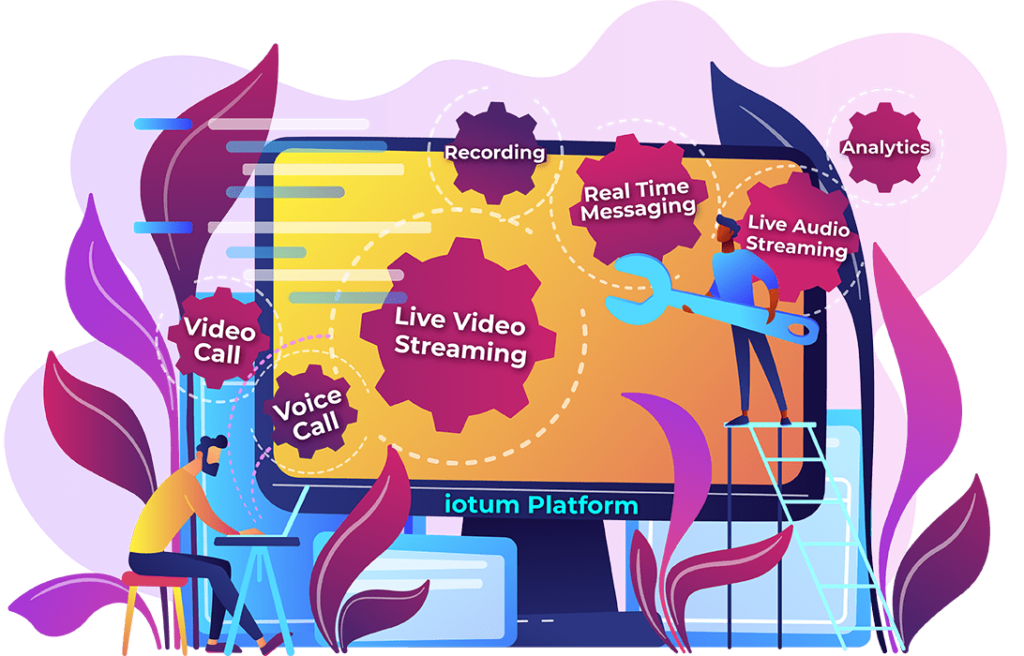 Stop for a second and think about all the daily interactions you might have with technology. Anywhere from using a chatbot on a website to ask a business a question to an online banking transaction from your smartphone to viewing a video tutorial on the website of a new brand you’ve just discovered.
Stop for a second and think about all the daily interactions you might have with technology. Anywhere from using a chatbot on a website to ask a business a question to an online banking transaction from your smartphone to viewing a video tutorial on the website of a new brand you’ve just discovered.
The opportunity to reach people virtually is exponential. Not only has it become an indispensable part of how we operate day to day, it’s a clear indicator of where we’re headed in the modern world. Companies and businesses are adopting a more flexible and adaptable workforce, therefore video chat API is only continuing to be more and more appealing.
As video chat app development carries over in the mainstream, you might find yourself in the consideration phase, asking questions like:
- How will API improve my connection with my audience?
- Can video chat API make a business stand out?
- Is it really possible to get a reliable video chat API without having to build it?
The answer to all the above is a resounding yes! But before you start, here’s what you need to know about integrating video call API.
An Application Programming Interface creates a connection between two or more applications so they can speak and interact with each other. A video chat API allows for businesses to add video call functionality where it wasn’t previously existent. It’s a cost-effective, seamlessly integrated option that allows for video that is customizable and doesn’t use up all resources. Plus, it’s already built which means less time-to-market.
Here’s a quick comparison between building your own and integrating an already-built solution:
| Creating Video Chat From Square One | Adding Video Chat API |
|---|---|
| High capital required for development | Zero capital required to start |
| Original infrastructure = Higher costs | Third party infrastructure = Low costs |
| Fully dedicated team needed as a resource | One developer needed as a resource |
| Months required for set up | Set up in short amount of time |
| Open ended security concerns | Secure and compliant according to most international regulations and guidelines (HIPAA, GDPR, etc) |
| Challenging to scale | Scales and grows alongside business |
| Lots of planning required to update | Updates in minutes |
Difficulties of creating a video chat app from the ground up can cost you time and money, and also resources. Not to mention the backend design and maintenance that follows:
- Complex And High Costs
It’s no surprise that building your very own video chat app requires competent resources, adequate server infrastructure and sufficient servers – all of which costs money upfront. Plus, the time to plan, build and maintain it. A dedicated team must be implemented and a thorough understanding of the standards and requirements must be communicated and adhered to in order to create a quality product. - Slow Time-to-Market
Playing catch up isn’t very appealing when you’re developing a video chat API when you’re trying to keep up with the competition in the first place. Development can eat up a lot of time, and therefore slow down the time-to-market of your product or service. Between designing, testing, debugging and all the other phases between concepting and launching, there’s no telling just how much disruption might happen.  Unstable Security
Unstable Security
Building your own video chat functionality doesn’t come with guarantees, especially in the realm of security. With so much room for privacy to go haywire, plus constantly changing compliance requirements, security breaches and regulations to meet, it’s not all that easy to create a trustworthy app. Regulations that include HIPAA and GDPR are evolving, which means that issues and protocols are ever changing. Not only does this slow down progress, it can also take up more time and money adhering to the cycles.
(alt-tag: View of peaceful woman working on laptop, seated on floor in stylish beige colored living room at home. )
On the other hand, choosing video chat API integration comes with a range of ready-made features and functions to plug in and play – plus a few appealing benefits:
- Low Costs
By and large, choosing a video chat API that fits into your already existing app is far more cost effective than making something out of nothing. Going straight to the source bypasses the cost of planning and design, development, infrastructure and set up. In turn, you can hit the ground running faster, using less sources and using your time and money more effectively, elsewhere. - Straightforward Implementation
By adding a cloud-based video and voice solution to your existing platform, you can see just how simple it is to make the crossover. Engaging with your audience in real-time on any platform from anywhere becomes straightforward with technology that’s already made and can be customized to match your app.  Heightened Security
Heightened Security
Security needs to be at your top of mind awareness when considering a video chat API. Not only are you opening up the channels for communication, you could make yourself vulnerable to hackers, and security breaches. With video conferencing API, security protocols are already taken very seriously.
(alt-tag: Back view of seated woman working at desk in front of laptop in white room beside curtained window, twiddling a pen and engaging with virtual teacher.)
So you’re ready to take the leap and make headway with an ultramodern video call API solution? Here’s how to integrate video call API in just 5 easy steps:
- Get Familiar With Your Users
Knowing the needs and expectations of your users is just good product research and development. Don’t skimp out on this; In-depth market knowledge will show you what your users need and want and give you a better idea of what to integrate and where. - Understand The Required Investment
Building a video chat app without a third party is absolutely possible – but be honest with your company’s goals, targets and projections. Does it make sense to spend additional money and resources to do that? What features do you need and how many do you want to include? Which ones do you want to exclude? Keep in mind, additional features will up the costs and may increase complexity. - See How The Tech Works
Know how the tech works to establish which API solution is compatible with your existing app. Having an idea of the underlying infrastructure and bandwidth of where you’re at and what you might need will give you a thorough understanding of what’s required for success. - Choose A Development Route
At this juncture, you can establish the pros and cons of the following two options:
1) Design and build your own video conferencing solution:
2) Integrate an API solution into your already existing structure. - Examine the App Design
Above all, for your audience, it’s about their experience with your interface and platform. Integrating video functionality into your existing app requires thought and planning so that it looks good and shines a positive light on your brand. Go with a video and voice API that not only seamlessly integrates, it offers customizable options that complement your forward-facing brand and business transactions.
Let iotum show you the style and simplicity behind integrating video chat API into your already existing platform. See how it works to cater to your business and grow your audience across a scalable network. Learn more here.


